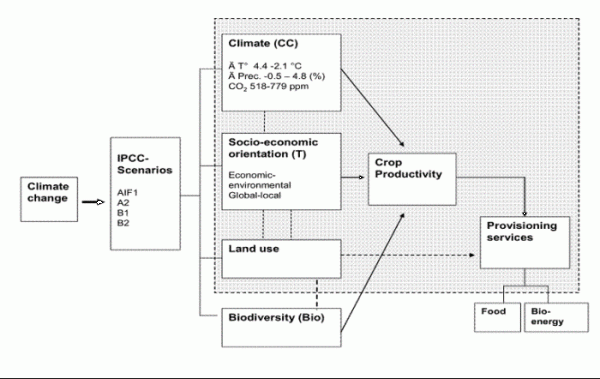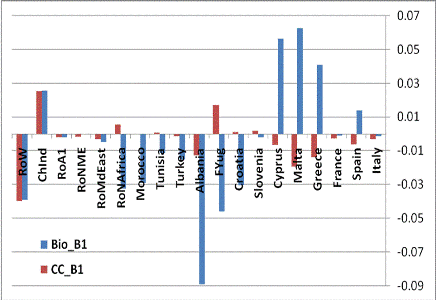| Versione italiana |
The research leading to these results has received funding from the European Union Sixth Framework Pro-gramme under the project 'Climate Change and Impact Research: the Mediterranean Environment - CIRCE', contract n. 036961.The authors thank S. Silvestri and Emanuele Lugato for their research assistance.
Introduction
It is clear that climate change involves changes in temperature and precipitation and therefore directly affects land productivity. However, this is not the only channel for climatic change to affect agro-systems. Biodiversity is su-bject to climatic fluctuations and in its tern may alter land productivity too. Firstly, biodiversity is an input into agro-ecosystems. Secondly, biodiversity supports the functioning of these systems (e.g. the balancing of the nutrient cycle). Thirdly, agro-ecosystems also host important wildlife species which, though not always, play a functional role in land productivity, nonetheless constitute important sources of landscape amenities.
The present paper illustrates a unique attempt to economically assess this additional effect climate change may imply on agriculture. This approach depicts the world economy as a system of markets interacting through e-xchanges of inputs, goods and services responding to changes in relative prices induced by climate shocks. To our knowledge, this exercise constitutes an original procedure, at a global level of analysis, in the economic welfa-re assessment of biodiversity impacts induced by climate change. We first empirically evaluate changes in land productivity due to climatic change effect on temperature, precipitations and biodiversity. Then we estimate the economic cost of biodiversity impact on agro-systems.
Assessing the impact of climate change on the provisioning services of agro-ecosystems
We distinguish between croplands and the grasslands due to the very different types of ecosystem goods and services that these two distinct agro-systems provide. This distinction is essential to the quantitative projections of ecosystem goods and services under the climate change scenarios, and ultimately to the economic valuation exercise.
Farmers play a dominant role in the context of agricultural biodiversity by the selection of the present biodiversity stock, by the modification of the abiotic environment and by interventions aimed at the regulation of specific popu-lations. Recent studies of intensive agro-ecosystems have pointed out that permanent grasslands represent “hot spots” of biodiversity (e.g. Giardi et al., 2002, Baglioni et al. 2009a, Baglioni et al. 2009b). The quality of soil is also higher in permanent grasslands with respect to arable lands as confirmed by the many soil quality indicators. Against this background, the ratio between cropland and grassland can be employed as a proxy indicator for the measurement of the levels biodiversity in agro-ecosystems. This, in turn, can be tested to determine if a signifi-cant role is played in the levels of supply of provisioning services. In other words, we can investigate whether this indicator affects the productivity of croplands. Furthermore, we propose to evaluate this link in the context of global climate change.
To understand the interface between climate change and the provisioning services of agro-ecosystems, a graphi-cal presentation is given in Figure 1 below. First of all, land productivity for different crops is affected by physical climatic variables (CC) including temperature and precipitation, and by the level of technology (T). In turn, both are anchored in the specific IPCC scenario under consideration ranging from AIF1 to B2. In addition, a biodiver-sity variable (Bio) is also assumed to impact land productivity.
Figure 1 - Methodological framework for the evaluation of IPCC story lines on agricultural provisioning services

Formally, we propose to estimate the β's of the following equation:

where CrP is the land productivity of harvested product, measured in t/ha, β0 is the intercept, Temp is the aver-age annual temperature (°C), P denotes the annual precipitation (mm), F is the total fertilizer consumption per hectare (Mt), Tr refers to the total tractors used per hectare, and GR/CL is the ratio of grassland to cropland. As expressed by the equation, land productivity is a function of physical variables (Temp and P), technological level (F and Tr) and a proxy of biodiversity (GR/CL).
We created a database for the analysis on wheat yields, covering 19 countries over the period 1974 and 2000. Information regarding wheat yield, grassland and cropland areas, total fertilizers used and total tractors is derived from FAO statistics whereas information about temperature and precipitation is derived from the Tyndall database. The regression model results are summarized in Table 1. We can see that the model is statistically significant, as are the other variables selected.
Table 1 - Crop productivity function for the estimation of the effects of biodiversity on wheat yield.

R= .74 R²= .55 Adjusted F(7,505)=89.247 p<0.0000 Std.Error of estimate: 1.1959
At this point, it was possible to calculate changes in land productivity due to changes in biodiversity based on the estimated variation of the ratio GR/CL for the IPCC scenarios in 2050.
Economic valuation of the linkages between climate change, biodiversity and the productivity of Euro-pean agro-ecosystems
Most of the economic studies of biodiversity end up with sectoral, partial-equilibrium analysis. However, agricultu-ral products are important market commodities for human consumption. The projection of the agricultural output and respective market prices are therefore subject to standard macro-economic theory, determined by the future supply and demands of these commodities under climate change scenarios. For this reason, we apply the quanti-tative information obtained from the physical projections in the previous section to a computable general equili-brium (CGE) model. This way we are able to evaluate, in economic terms, the impact of climate-change-induced variation in biodiversity on the productivity of agro-systems.
We employ a static multi-regional CGE model of the world economy called GTAP-EF (Roson, 2003; Bigano et al., 2006). It is calibrated to replicate regional GDP growth paths consistent with the A2 IPCC scenario and is then used to assess climate change economic impacts in 2050 with respect to 2000.
Although regional and industrial disaggregation in the model may vary, the results presented here refer to 19 macro-regions in which several European countries appear disaggregated, as distinct economic entities, whereas the rest of the world is aggregated in four major trading blocks. Regional economies are represented by 19 sec-tors which can be classified in three major industries, where land using industries are presented in broadest di-saggregation possible in GTAP database.
Proposed here economic valuation of consequences of climate-change-induced change in biodiversity is fastened in a two step approach. The first step is creating benchmark data-sets for the world economy “without climate change” at year 2050, using the methodology described in Bosello and Zhang (2005). The second step is impo-sing over this benchmark equilibrium climate-change-induced temperature and precipitaions (CC), as well as biodiversity (Bio) impacts on land productivity for crops in different regions employing estimations presented in Table 1. For GTAP-EF regions, which absent from analysis in the previous section, we used values from available countries in same geo-climatic category. We run this model for four scenarios about the climate (A1F1, A2, B1, B2). In this way, GTAP-EF generates three sets of results: a baseline growth for the world economy, in which climate change impacts are ignored, and counterfactual scenarios in which temperature and precipitaions, and biodiversity impacts are imposed.
The results present a significant effect of biodiversity above direct climatic impact can be observed. The compari-son between climate induced temperature (CC) impact with the combined effect of temperature and biodiversity (Bio) on agricultural output and regional GDP allows to detect the marginal effect of biodiversity on these econo-mic variables. As illustrates Figure 2, for some regions, the added effect of biodiversity operates in the same direction as temperature change. However, there are regions where this effect is reversed and in some cases it is even larger than temperature impact so that the overall effect operates in the opposite direction. This GDP pattern presents in all IPCC storylines.
Figure 2 - Change in regional GDP in 2050 due to temperature and biodiversity variation under B1 storyline versus baseline (in %).

The results bring to the following conclusions: a) for the European Mediterranean countries, the climate-change-induced effects of biodiversity on agricultural productivity, when measured in terms of changes in GDP, are non-negative; b) in particular, for the majority part of the European Mediterranean countries B1 type of climate change scenario, the inclusion of this valuation transmission mechanism is able to reverse the marginal loss of GDP obtained under climate-change-alone impact evaluation (with the exception of Italy and France); c) for all the rest of the Mediterranean countries as well as for Rest of Middle East region, the climate-change-induced effects of biodiversity on agricultural productivity, when measured in terms of changes in GDP, is negative; i.e. the observed biodiversity impacts will further decrease the level of human welfare of these populations as originally measured by the CGE model.
To summarize, despite the fact that in general we are assisting to a worldwide decrease in the levels of biological diversity, from an economic perspective, which is here approached from the productivity of the agro-ecosystems, this stylized fact is not always corresponding to a similar welfare or GDP change pattern to all. In fact not only European countries will experience diverse impacts. Some countries will lose more than others, and some coun-tries will gain, depending on the geographical location, existing markets and profile with respect to biodiversity indicators and land use patterns.
Conclusions
Our results indicate that while developed regions lose slightly, or even gain as in the case of Central and Northern Europe, developing regions can lose considerably more. This highlights their greater vulnerability to climatic change with respect to developed economies, a vulnerability that results from a combination of higher degrees of exposure and sensitivity. Particularly enlightening is the case of Mediterranean Europe where initial negative impacts are eventually turned into gains. There, negative direct impacts are in fact counterbalanced by terms of trade improvements. Even in terms of final impacts on economic activity, the developing world is more severely affected than the developed one.
We can conclude that economic valuation of climate-change-caused impacts on biodiversity and ecosystem ser-vices are multifaceted. This aspect, i.e. climate-change-caused impacts on biodiversity and ecosystem services are not distributed in a uniform way across the European countries under consideration.
The crucial point that we raise here is that the economies, which also reflect complex social systems, show diffe-rent resilience profiles to deal with this type of effects; some economies, and respective social systems, are able to buffer the impacts, others not. Naturally further research is needed to better understand the ecological-social systems interactions and the role of biodiversity as a determinant.
References
-
Baglioni, M.. Macagno, G, Nunes, P.A.L.D and C. Travisi (2009a) Natura 2000 Network and Agricultural Activi-ties: Analysing the potential of the Natura 2000 database in developing agricultural pressure indices, Report of the EXIOPOL, Deliverable.II.3.b.1. part 1, Milano, Italy.
-
Baglioni, M.. Macagno, G, Nunes, P.A.L.D and C. Travisi (2009b) Natura 2000 Network, Agricultural Pressures and Biodiversity Conservation: an Italian outlook: Analysing the potential of the Natura 2000 database in descri-bing the linkages between agricultural pressures and biodiversity. Report of the EXIOPOL, Deliverable.II.3.b.1. part 2, Milano, Italy.
-
Bigano A., Bosello F., Roson R. and Tol, R.S.J. (2006), Economy-Wide Estimates of the Implications of Climate Change: a Joint Analysis for Sea Level Rise and Tourism, Fondazione Eni Enrico Mattei Working Paper N.135.2006.
-
Bosello F., and J. Zhang. “Assessing Climate Change Impacts: Agriculture.” FEEM Working Paper, 94. 2005. FAO, [link]
-
Roson, R., (2003), Modelling the Economic Impact of Climate Change, EEE Programme Working Papers Series.

